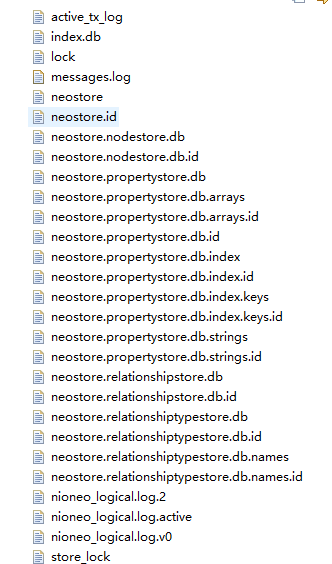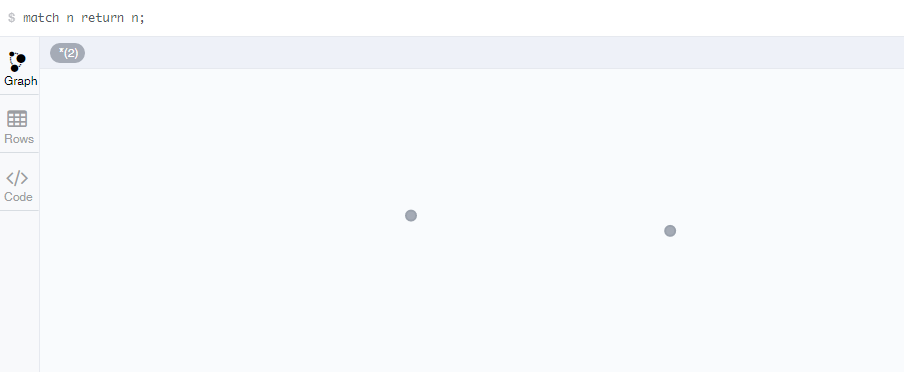neo4j-jersey分嵌入式和服务式连接图形数据库
原文载自:http://blog.csdn.net/yidian815/article/details/12887259
嵌入式:
引入neo4j依赖
<dependency>
<groupId>org.neo4j</groupId>
<artifactId>neo4j</artifactId>
<version>1.9.4</version>
</dependency>
创建一个neo4j.properties(数据库的配置文件)
# Default values for the low-level graph engine
#neostore.nodestore.db.mapped_memory=25M
#neostore.relationshipstore.db.mapped_memory=50M
#neostore.propertystore.db.mapped_memory=90M
#neostore.propertystore.db.strings.mapped_memory=130M
#neostore.propertystore.db.arrays.mapped_memory=130M # Autoindexing # Enable auto-indexing for nodes, default is false
#node_auto_indexing=true # The node property keys to be auto-indexed, if enabled
#node_keys_indexable=name,age # Enable auto-indexing for relationships, default is false
#relationship_auto_indexing=true # The relationship property keys to be auto-indexed, if enabled
#relationship_keys_indexable=name,age # Keep logical logs, needed for online backups to work
keep_logical_logs=true # Enable online backups to be taken from this database.
online_backup_enabled=true # Uncomment and specify these lines for running Neo4j in High Availability mode.
# ha.server_id is a unique integer for each instance of the Neo4j database in the cluster.
# (as opposed to the coordinator instance IDs)
# example: ha.server_id=1
#ha.server_id= # ha.coordinators is a comma-separated list (without spaces) of the host:port of where to
# find one or more of the Neo4j coordinator servers.
# Avoid localhost due to IP resolution issues on some systems.
# example: ha.coordinators=localhost:2181,1.2.3.4:4321
#ha.coordinators=localhost:2181 # You can also, optionally, configure the ha.cluster_name. This is the name of the cluster this
# instance is supposed to join. Accepted characters are alphabetical, numerical, dot and dash.
# This configuration is useful if you have multiple Neo4j HA clusters managed by the same
# Coordinator cluster.
# Example: ha.cluster_name = my.neo4j.ha.cluster
#ha.cluster_name = # IP and port for this instance to bind to to communicate data with the
# other neo4j instances in the cluster. This is broadcasted to the other
# cluster members, so different members can have different communication ports.
# Optional if the members are on different machines so the IP is different for every member.
#ha.server = localhost:6001 # The interval at which slaves will pull updates from the master. Comment out
# the option to disable periodic pulling of updates. Unit is seconds.
ha.pull_interval = 10 # The session timeout for the zookeeper client. Lower values make new master
# election happen closer to the master loosing connection but also more sensitive
# to zookeeper quorum hiccups. If experiencing master switches without reason
# consider increasing this value. Unit is seconds
#ha.zk_session_timeout = 5 # Amount of slaves the master will try to push a transaction to upon commit (default is 1).
# The master will optimistically continue and not fail the transaction even if it fails to
# reach the push factor. Setting this to 0 will increase write performance when writing
# through master but could potentially lead to branched data (or loss of transaction)
# if the master goes down.
#ha.tx_push_factor=1 # Strategy the master will use when pushing data to slaves (if the push factor is greater than 0).
# There are two options available "fixed" (default) or "round_robin". Fixed will start by
# pushing to slaves ordered by server id (highest first) improving performance since the
# slaves only have to cache up one transaction at a time.
#ha.tx_push_strategy=fixed # Enable this to be able to upgrade a store from 1.4 -> 1.5 or 1.4 -> 1.6
#allow_store_upgrade=true # Enable this to specify a parser other than the default one. 1.5, 1.6, 1.7 are available
#cypher_parser_version=1.6
java文件(neo4j示例文件修改而来)
package org.easypoint; import java.io.File;
import java.io.IOException;
import org.neo4j.graphdb.Direction;
import org.neo4j.graphdb.GraphDatabaseService;
import org.neo4j.graphdb.Node;
import org.neo4j.graphdb.Relationship;
import org.neo4j.graphdb.RelationshipType;
import org.neo4j.graphdb.Transaction;
import org.neo4j.graphdb.factory.GraphDatabaseFactory;
import org.neo4j.kernel.impl.util.FileUtils; public class Learn1
{
private static final String DB_PATH = "target/neo4j-hello-db";
String greeting;
// START SNIPPET: vars
GraphDatabaseService graphDb;
Node firstNode;
Node secondNode;
Relationship relationship;
// END SNIPPET: vars // START SNIPPET: createReltype
private static enum RelTypes implements RelationshipType
{
KNOWS
}
// END SNIPPET: createReltype public static void main( final String[] args )
{
Learn1 hello = new Learn1();
hello.createDb();
hello.removeData();
hello.shutDown();
} void createDb()
{
clearDb();
// START SNIPPET: startDb
graphDb = new GraphDatabaseFactory()
.newEmbeddedDatabaseBuilder( "target/database/learn1" )
.loadPropertiesFromFile(Learn1.class.getResource("/").getPath()+"neo4j.properties" )
.newGraphDatabase(); registerShutdownHook( graphDb );
// END SNIPPET: startDb // START SNIPPET: transaction
Transaction tx = graphDb.beginTx();
try
{
// Updating operations go here
// END SNIPPET: transaction
// START SNIPPET: addData
firstNode = graphDb.createNode();
firstNode.setProperty( "message", "Hello, " );
secondNode = graphDb.createNode();
secondNode.setProperty( "message", "World!" ); relationship = firstNode.createRelationshipTo( secondNode, RelTypes.KNOWS );
relationship.setProperty( "message", "brave Neo4j " );
// END SNIPPET: addData // START SNIPPET: readData
System.out.print( firstNode.getProperty( "message" ) );
System.out.print( relationship.getProperty( "message" ) );
System.out.print( secondNode.getProperty( "message" ) );
// END SNIPPET: readData greeting = ( (String) firstNode.getProperty( "message" ) )
+ ( (String) relationship.getProperty( "message" ) )
+ ( (String) secondNode.getProperty( "message" ) ); // START SNIPPET: transaction
tx.success();
}
finally
{
tx.finish();
}
// END SNIPPET: transaction
} private void clearDb()
{
try
{
FileUtils.deleteRecursively( new File( DB_PATH ) );
}
catch ( IOException e )
{
throw new RuntimeException( e );
}
} void removeData()
{
Transaction tx = graphDb.beginTx();
try
{
// START SNIPPET: removingData
// let's remove the data
firstNode.getSingleRelationship( RelTypes.KNOWS, Direction.OUTGOING ).delete();
firstNode.delete();
secondNode.delete();
// END SNIPPET: removingData tx.success();
}
finally
{
tx.finish();
}
} void shutDown()
{
System.out.println();
System.out.println( "Shutting down database ..." );
// START SNIPPET: shutdownServer
graphDb.shutdown();
// END SNIPPET: shutdownServer
} // START SNIPPET: shutdownHook
private static void registerShutdownHook( final GraphDatabaseService graphDb )
{
// Registers a shutdown hook for the Neo4j instance so that it
// shuts down nicely when the VM exits (even if you "Ctrl-C" the
// running application).
Runtime.getRuntime().addShutdownHook( new Thread()
{
@Override
public void run()
{
graphDb.shutdown();
}
} );
}
// END SNIPPET: shutdownHook
}
运行java文件,可以看到在target/database/下创建了一个learn1的数据库。

从java代码我们也可以看出,neo4j数据库主要依靠node,relationship和property来存储数据,利用relationship将各个node链接起来。
服务式:
1.简单暴力连接(使用jdbc):http://www.cnblogs.com/hwaggLee/p/5956541.html
2.使用JERSEY
添加依赖jar
<dependency>
<groupId>com.sun.jersey</groupId>
<artifactId>jersey-project</artifactId>
<version>1.17</version>
</dependency> <dependency>
<groupId>com.sun.jersey</groupId>
<artifactId>jersey-server</artifactId>
<version>1.17</version>
</dependency> <dependency>
<groupId>com.sun.jersey</groupId>
<artifactId>jersey-client</artifactId>
<version>1.17</version>
</dependency> <dependency>
<groupId>com.sun.jersey</groupId>
<artifactId>jersey-core</artifactId>
<version>1.17</version>
</dependency> <dependency>
<groupId>com.sun.jersey</groupId>
<artifactId>jersey-json</artifactId>
<version>1.17</version>
</dependency>
新建java类Learn1Rest
package org.easypoint; import com.sun.jersey.api.client.ClientResponse;
import com.sun.jersey.api.client.WebResource;
import com.sun.jersey.api.client.Client;
import java.net.URI;
import javax.ws.rs.core.MediaType;
/**
* 服务式neo4j连接
*/
public class Learn1Rest {
public static void main(String args[]){
Learn1Rest lr = new Learn1Rest();
URI firstNode = lr.createNode();
lr.addProperty( firstNode, "name", "Joe Strummer" );
URI secondNode = lr.createNode();
lr.addProperty( secondNode, "band", "The Clash" ); } public URI createNode(){
String SERVER_ROOT_URI = "http://61.xxx.xxx.xx:7474/db/data/";
final String nodeEntryPointUri = SERVER_ROOT_URI + "node";
WebResource resource = Client.create().resource(nodeEntryPointUri); ClientResponse response = resource.accept( MediaType.APPLICATION_JSON )
.type(MediaType.APPLICATION_JSON)
.entity("{}")
.post(ClientResponse.class);
final URI location = response.getLocation();
System.out.println( String.format("POST to [%s], status code [%d], location header [%s]",
nodeEntryPointUri, response.getStatus(), location.toString() ) );
response.close();
return location; } public void addProperty(URI nodeUri,String propertyName, String propertyValue){
String propertyUri = nodeUri.toString() + "/properties/" + propertyName;
WebResource resource = Client.create()
.resource( propertyUri );
ClientResponse response = resource.accept( MediaType.APPLICATION_JSON )
.type( MediaType.APPLICATION_JSON )
.entity( "\"" + propertyValue + "\"" )
.put( ClientResponse.class );
System.out.println( String.format( "PUT to [%s], status code [%d]",
propertyUri, response.getStatus() ) );
response.close(); }
}
执行成功

数据库查询:

neo4j-jersey分嵌入式和服务式连接图形数据库的更多相关文章
- Android应用程序窗口(Activity)与WindowManagerService服务的连接过程分析
在前两文中,我们分析了Activity组件的窗口对象和视图对象的创建过程.Activity组件在其窗口对象和视图对象创建完成之后,就会请求与WindowManagerService建立一个连接,即请求 ...
- Android应用程序与SurfaceFlinger服务的连接过程分析
文章转载至CSDN社区罗升阳的安卓之旅,原文地址:http://blog.csdn.net/luoshengyang/article/details/7857163 前文在描述Android应用程序和 ...
- 原创:Equinox OSGi应用嵌入Jersey框架搭建REST服务
一.环境 eclipse版本:eclipse-luna 4.4 jre版本:1.8 二.Equinox OSGi应用嵌入Jersey框架搭建REST服务 1.新建插件工程HelloWebOSGI a. ...
- DLL模块例2:使用__declspec(dllexport)导出函数,extern "C"规范修饰名称,隐式连接调用dll中函数
以下内容,我看了多篇文章,整合在一起,写的一个例子,关于dll工程的创建,请参考博客里另一篇文章:http://www.cnblogs.com/pingge/articles/3153571.html ...
- CSS的三种样式:内联式,嵌入式,外部式以及他们的优先级
从CSS 样式代码插入的形式来看基本能够分为下面3种:内联式.嵌入式和外部式三种. 1:内联式css样式表就是把css代码直接写在现有的HTML标签中,如以下代码: <p style=" ...
- 打印机威胁:嵌入式Web服务有安全问题
现在大多数打印机.扫描仪,以及VoIP系统等设备都会内建嵌入式的Web服务,这主要是为了方便管理.然而不幸的是,这些设备大多会由于设置问题而处在无保护状态下.有些服务甚至可以使用默认的帐号和密码访问, ...
- ssh服务突然连接不了案例总结
ssh服务突然连接不了案例总结 一台Oracle数据库服务器(Linux版本为Oracle Linux Server release 5.7)今天中午突然出现短暂的ssh连接不上的情况,ssh连接 ...
- Equinox OSGi应用嵌入Jersey框架搭建REST服务
原文地址:https://www.cnblogs.com/kira2will/p/5040264.html 一.环境 eclipse版本:eclipse-luna 4.4 jre版本:1.8 二.Eq ...
- springcloud服务安全连接
Spring Cloud可以增加HTTP Basic认证来增加服务连接的安全性. 1.加入security启动器 在maven配置文件中加入Spring Boot的security启动器. <d ...
随机推荐
- wpf 列表、菜单 收起与展开,通过Grid DoubleAnimation或者Expander实现
菜单收缩有很多种方法具体如何实现还是看个人想法: 第一种通过后台控制收起与展开: 效果图: 代码 : <Grid> <Grid.ColumnDefinitions> <C ...
- Lightbox改造——支持滚轮缩放
在做文章类型的web页时,经常会遇到要点开看大图的需求,LightBox2则是在众多产品中比较优秀的一款Jquery插件.配置就不细说了,今天我主要要分享的是:如何在点开大图后,可以通过鼠标滚轮来缩放 ...
- hdu-2444-二分图判定+最大分配
The Accomodation of Students Time Limit: 5000/1000 MS (Java/Others) Memory Limit: 32768/32768 K ( ...
- 《连载 | 物联网框架ServerSuperIO教程》- 14.配制工具介绍,以及设备驱动、视图驱动、服务实例的挂载
注:ServerSuperIO二次开发套件授权码申请---截止到:2016-12-09 1.C#跨平台物联网通讯框架ServerSuperIO(SSIO)介绍 <连载 | 物联网框架Server ...
- Bootstrap 之 Carousel
Bootstrap 轮播(Carousel)插件是一种灵活的响应式的向站点添加滑块的方式.除此之外,内容也是足够灵活的,可以是图像.内嵌框架.视频或者其他您想要放置的任何类型的内容. 如果您想要单独引 ...
- 蓝牙Bluetooth技术小知识
蓝牙Bluetooth技术以及广泛的应用于各种设备,并将继续在物联网IoT领域担任重要角色.下面搜集整理了一些关于蓝牙技术的小知识,以备参考. 蓝牙Bluetooth技术始创于1994年,其名字来源于 ...
- 用NSCalendar和UICollectionView自定义日历,并实现签到显示
前一段时间因为工作需要实现了一个可以签到的日历,来记录一下实现的思路 效果如图: 这里的基本需求是: 1,显示用户某个月的签到情况,已经签到的日子打个圈,没有签到且在某个时间范围内的可以签到,其他 ...
- android 自定义控件——(四)圆形进度条
----------------------------------↓↓圆形进度条(源代码下有属性解释)↓↓---------------------------------------------- ...
- json相关类库,java对象与json相互转换
有效选择七个关于Java的JSON开源类库 转自:http://www.open-open.com/lib/view/open1397870197828.html 翻译: (英语原文:http://w ...
- yii2中如何使用modal弹窗之基本使用
作者:白狼 出处:http://www.manks.top/yii2_modal_baseuse.html 本文版权归作者,欢迎转载,但未经作者同意必须保留此段声明,且在文章页面明显位置给出原文连接, ...
